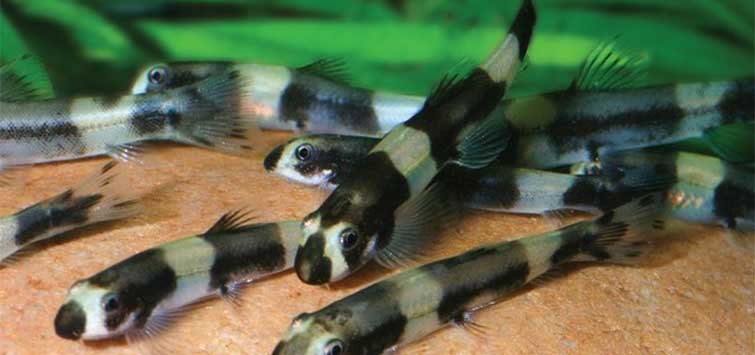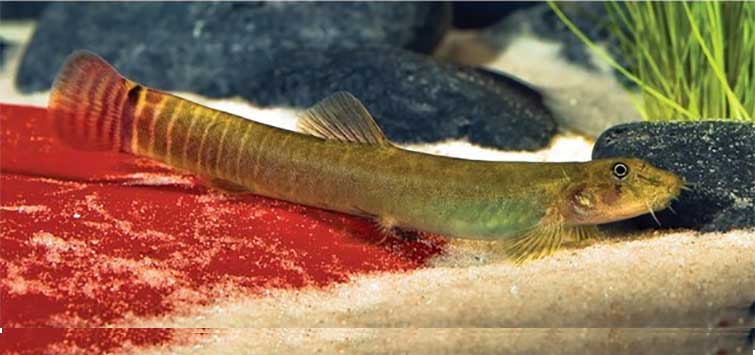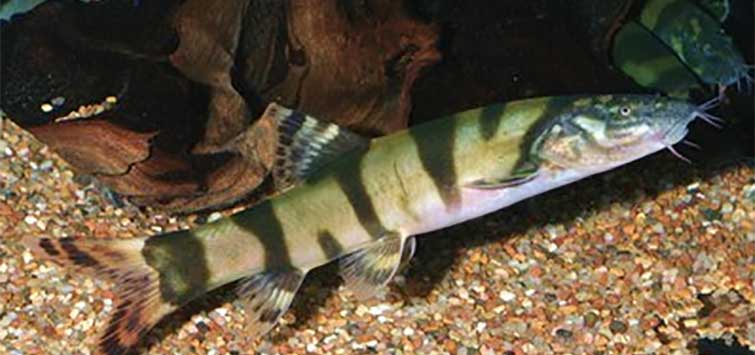A Panda of a Different Nature
Author: Stan Sung
Our fervent traveler visits a remote, mountainous region in China to collect its precious and exclusive treasure, the panda loach.
The giant pandas are natural treasures that hail from the emerald forests of China. A gem of a fish that shares the same name also comes from this vast and legendary land: the panda loach Protomyzon pachychilus. This species has only recently been imported for the aquarium trade. The striking, velvety black bands and snow-white body of young P. pachychilus resemble the iconic coloration and patterning of China’s beloved giant panda.
Panda Loach Natural Habitat
We took a rocking, rolling 10-hour ride through the night on an unlicensed bus to reach the location of P. pachychilus. These unlicensed buses have makeshift beds—unbolted wire frames with mattresses set haphazardly along the floor of the bus. The treacherous mountain roads made this a long ride through the darkness of night.
The bus reached Guangxi Province at daybreak, and from a remote village we took a several-hour-long hike to reach the first of three streams where the panda loach has thus far been collected. At the end of the dirt road (at an altitude of approximately 3000 feet) is a running creek that meanders through rocks and brush. Small waterfalls interspersed with slack-water pools punctuate the watercourse.
Juvenile panda loaches are easily spotted with their bold patterns as they perch on submersed rocks in the crystalline water. These loaches are not shy in nature or the aquarium. Young P. pachychilus are solitary in their natural habitat. Curiously, adults are often found in small, communal groups of five to seven individuals.
The pH of the water is 7.2 while the hardness is undetectable. This means that freshly collected wild fish need to be kept in very soft water and carefully acclimated over a period of several weeks through regular water changes to local water conditions.
Reproducing These Rare Fish
It is imperative that any hobbyist fortunate enough to come across panda loaches for sale purchase them with the goal of reproducing them. These black and white beauties have only been collected in two or possibly three streams in nature, and one of these streams contains a population that may not be P. pachychilus. Specimens in this stream show considerable differences in color pattern. Instead of the bold black and white banding of the juvenile pandas, these individuals from the third stream exhibit a pattern of two dark bands running longitudinally along the length of the body (as in the fully mature standard panda loach). In between these two dark bands are several thin bands that create a pattern of a ladder placed on its side.
The patterning is quite similar to the dwarf chain loach Yasuhikotakia sidthimunki. Besides the obvious color and pattern differences, this variety (or species) is, for all other purposes in habits and behavior, the same as the standard panda loach.
While on the subject of patterns, it should be noted that the coloration of P. pachychilus changes as these fish mature. The four black bar-like patches of the young fish will break up into several much thinner bars. Additionally, a set of two or three dark lines will run the length of the fish horizontally.
Because of the limited habitat, P. pachychilus is a species vulnerable to over-collection or habitat degradation/alteration. Collections at this remote site are few and far between, and at any time these fish could be protected and unavailable for the aquarium trade. Their native habitat is not inside a national park, and this species could have a perilous future.
To my knowledge, the panda loach has not been bred at this time in captivity. Many species of hillstream loaches have been successfully reproduced and raised in aquaria. It is most important to place a small group of these fish in the proper conditions to encourage spawning behavior.
Panda Loach Aquarium Needs
Panda loaches that appear in the aquarium trade at the time of this writing are undoubtedly wild-caught specimens that have been adapted to standard tap water. The little panda loaches appear to be quite content in any type of water as long as extremes are avoided. What they do require is current and oxygen-rich conditions. A regimen of regular water changes should be performed.
I have two powerful, submersible power filters that return water at the aquarium surface. These return jets aerate and circulate the water in their habitat, much like the pull of the stream in their natural environment. I also have a couple of airstones in their tank to ensure that the water is thoroughly saturated with oxygen.
Smooth river rocks should be placed in their accommodations. It is not only fun to see the little pandas perch and play among the rocks, but you will observe them rasping algae off of the smooth surface of the river stones.
Panda loaches are a joy to keep. Unlike many of their cousins, these tiny jewels show no fear and are not inclined to hide at all. They may retire to a shelter but as soon as food is offered, they come right out. P. pachychilus are not offensive toward each other or other species. Sometimes they will chase each other, usually at feeding time, but these harmless squabbles never end in injury or true aggression.
Their environmental temperature varies drastically in nature. They can withstand temperatures between 50° and 80°F. For standard maintenance, room-temperature water suits them wonderfully. The serious hobbyist intent on breeding them may want to experiment by adjusting the aquarium temperature and photoperiod seasonally.
Due to their diminutive size (2¼ inches at maturity) and peaceful nature, pandas do not need overly large accommodations. An aquarium of 20 gallons should be sufficient for a colony of these loaches. No matter what size the aquarium, be especially careful to maintain high water quality.
Panda Loach Diet
Panda loaches appear to be almost exclusively herbivorous. Their main diet can be sinking algae wafers. I will also offer mine crumbled flake food and scalded lettuce or spring greens. There is some evidence that feeding primarily meaty foods can be linked to losses in captivity. P. pachychilus are greedy feeders. Due to their active nature and small size, it is best if they are fed twice daily.
A Panda for Your Home?
It is with great hope that this exciting and new import is here to stay. These little beauties will look fantastic in small, planted aquariums with other nano fishes such as galaxy rasboras and white clouds Tanichthys spp. It isof utmost importance that this fish is captive bred and that any captive breeding events be published. Other hillstream loaches have been bred in aquaria, and there really is no reason that we could not expect the same from the panda loach. Most of these fishes will live and breed in a colony—and who wouldn’t want a colony of these striking, black and white loaches from the misty, verdant highlands of China?
See the full article on TFH Digital http://www.tfhdigital.com/tfh/201102#pg63

.png?h=595&iar=0&w=2781&hash=5FD5E69473BCC22199FBFA2FB71B6033)



